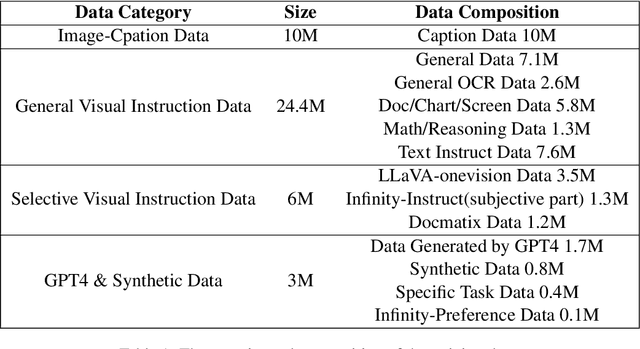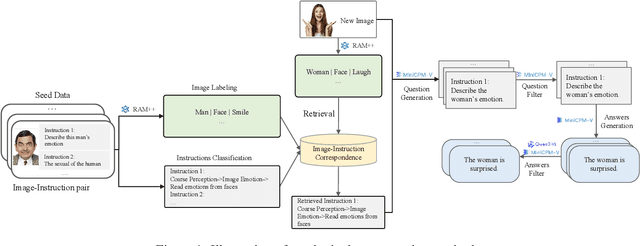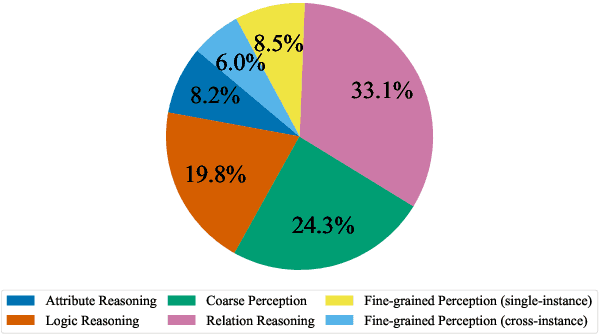Shuhao Gu
CCI3.0-HQ: a large-scale Chinese dataset of high quality designed for pre-training large language models
Oct 24, 2024Abstract:We present CCI3.0-HQ (https://huggingface.co/datasets/BAAI/CCI3-HQ), a high-quality 500GB subset of the Chinese Corpora Internet 3.0 (CCI3.0)(https://huggingface.co/datasets/BAAI/CCI3-Data), developed using a novel two-stage hybrid filtering pipeline that significantly enhances data quality. To evaluate its effectiveness, we trained a 0.5B parameter model from scratch on 100B tokens across various datasets, achieving superior performance on 10 benchmarks in a zero-shot setting compared to CCI3.0, SkyPile, and WanjuanV1. The high-quality filtering process effectively distills the capabilities of the Qwen2-72B-instruct model into a compact 0.5B model, attaining optimal F1 scores for Chinese web data classification. We believe this open-access dataset will facilitate broader access to high-quality language models.
Infinity-MM: Scaling Multimodal Performance with Large-Scale and High-Quality Instruction Data
Oct 24, 2024



Abstract:Vision-Language Models (VLMs) have recently made significant progress, but the limited scale and quality of open-source instruction data hinder their performance compared to closed-source models. In this work, we address this limitation by introducing Infinity-MM, a large-scale multimodal instruction dataset with 40 million samples, enhanced through rigorous quality filtering and deduplication. We also propose a synthetic instruction generation method based on open-source VLMs, using detailed image annotations and diverse question generation. Using this data, we trained a 2-billion-parameter VLM, Aquila-VL-2B, achieving state-of-the-art (SOTA) performance for models of similar scale. This demonstrates that expanding instruction data and generating synthetic data can significantly improve the performance of open-source models.
ReTok: Replacing Tokenizer to Enhance Representation Efficiency in Large Language Model
Oct 06, 2024Abstract:Tokenizer is an essential component for large language models (LLMs), and a tokenizer with a high compression rate can improve the model's representation and processing efficiency. However, the tokenizer cannot ensure high compression rate in all scenarios, and an increase in the average input and output lengths will increases the training and inference costs of the model. Therefore, it is crucial to find ways to improve the model's efficiency with minimal cost while maintaining the model's performance. In this work, we propose a method to improve model representation and processing efficiency by replacing the tokenizers of LLMs. We propose replacing and reinitializing the parameters of the model's input and output layers with the parameters of the original model, and training these parameters while keeping other parameters fixed. We conducted experiments on different LLMs, and the results show that our method can maintain the performance of the model after replacing the tokenizer, while significantly improving the decoding speed for long texts.
Aquila2 Technical Report
Aug 14, 2024Abstract:This paper introduces the Aquila2 series, which comprises a wide range of bilingual models with parameter sizes of 7, 34, and 70 billion. These models are trained based on an innovative framework named HeuriMentor (HM), which offers real-time insights into model convergence and enhances the training process and data management. The HM System, comprising the Adaptive Training Engine (ATE), Training State Monitor (TSM), and Data Management Unit (DMU), allows for precise monitoring of the model's training progress and enables efficient optimization of data distribution, thereby enhancing training effectiveness. Extensive evaluations show that the Aquila2 model series performs comparably well on both English and Chinese benchmarks. Specifically, Aquila2-34B demonstrates only a slight decrease in performance when quantized to Int4. Furthermore, we have made our training code (https://github.com/FlagOpen/FlagScale) and model weights (https://github.com/FlagAI-Open/Aquila2) publicly available to support ongoing research and the development of applications.
AquilaMoE: Efficient Training for MoE Models with Scale-Up and Scale-Out Strategies
Aug 13, 2024Abstract:In recent years, with the rapid application of large language models across various fields, the scale of these models has gradually increased, and the resources required for their pre-training have grown exponentially. Training an LLM from scratch will cost a lot of computation resources while scaling up from a smaller model is a more efficient approach and has thus attracted significant attention. In this paper, we present AquilaMoE, a cutting-edge bilingual 8*16B Mixture of Experts (MoE) language model that has 8 experts with 16 billion parameters each and is developed using an innovative training methodology called EfficientScale. This approach optimizes performance while minimizing data requirements through a two-stage process. The first stage, termed Scale-Up, initializes the larger model with weights from a pre-trained smaller model, enabling substantial knowledge transfer and continuous pretraining with significantly less data. The second stage, Scale-Out, uses a pre-trained dense model to initialize the MoE experts, further enhancing knowledge transfer and performance. Extensive validation experiments on 1.8B and 7B models compared various initialization schemes, achieving models that maintain and reduce loss during continuous pretraining. Utilizing the optimal scheme, we successfully trained a 16B model and subsequently the 8*16B AquilaMoE model, demonstrating significant improvements in performance and training efficiency.
Addressing the Length Bias Problem in Document-Level Neural Machine Translation
Nov 20, 2023Abstract:Document-level neural machine translation (DNMT) has shown promising results by incorporating more context information. However, this approach also introduces a length bias problem, whereby DNMT suffers from significant translation quality degradation when decoding documents that are much shorter or longer than the maximum sequence length during training. %i.e., the length bias problem. To solve the length bias problem, we propose to improve the DNMT model in training method, attention mechanism, and decoding strategy. Firstly, we propose to sample the training data dynamically to ensure a more uniform distribution across different sequence lengths. Then, we introduce a length-normalized attention mechanism to aid the model in focusing on target information, mitigating the issue of attention divergence when processing longer sequences. Lastly, we propose a sliding window strategy during decoding that integrates as much context information as possible without exceeding the maximum sequence length. The experimental results indicate that our method can bring significant improvements on several open datasets, and further analysis shows that our method can significantly alleviate the length bias problem.
Enhancing Neural Machine Translation with Semantic Units
Oct 17, 2023Abstract:Conventional neural machine translation (NMT) models typically use subwords and words as the basic units for model input and comprehension. However, complete words and phrases composed of several tokens are often the fundamental units for expressing semantics, referred to as semantic units. To address this issue, we propose a method Semantic Units for Machine Translation (SU4MT) which models the integral meanings of semantic units within a sentence, and then leverages them to provide a new perspective for understanding the sentence. Specifically, we first propose Word Pair Encoding (WPE), a phrase extraction method to help identify the boundaries of semantic units. Next, we design an Attentive Semantic Fusion (ASF) layer to integrate the semantics of multiple subwords into a single vector: the semantic unit representation. Lastly, the semantic-unit-level sentence representation is concatenated to the token-level one, and they are combined as the input of encoder. Experimental results demonstrate that our method effectively models and leverages semantic-unit-level information and outperforms the strong baselines. The code is available at https://github.com/ictnlp/SU4MT.
Continual Learning of Neural Machine Translation within Low Forgetting Risk Regions
Nov 04, 2022Abstract:This paper considers continual learning of large-scale pretrained neural machine translation model without accessing the previous training data or introducing model separation. We argue that the widely used regularization-based methods, which perform multi-objective learning with an auxiliary loss, suffer from the misestimate problem and cannot always achieve a good balance between the previous and new tasks. To solve the problem, we propose a two-stage training method based on the local features of the real loss. We first search low forgetting risk regions, where the model can retain the performance on the previous task as the parameters are updated, to avoid the catastrophic forgetting problem. Then we can continually train the model within this region only with the new training data to fit the new task. Specifically, we propose two methods to search the low forgetting risk regions, which are based on the curvature of loss and the impacts of the parameters on the model output, respectively. We conduct experiments on domain adaptation and more challenging language adaptation tasks, and the experimental results show that our method can achieve significant improvements compared with several strong baselines.
Improving Zero-Shot Multilingual Translation with Universal Representations and Cross-Mappings
Oct 28, 2022Abstract:The many-to-many multilingual neural machine translation can translate between language pairs unseen during training, i.e., zero-shot translation. Improving zero-shot translation requires the model to learn universal representations and cross-mapping relationships to transfer the knowledge learned on the supervised directions to the zero-shot directions. In this work, we propose the state mover's distance based on the optimal theory to model the difference of the representations output by the encoder. Then, we bridge the gap between the semantic-equivalent representations of different languages at the token level by minimizing the proposed distance to learn universal representations. Besides, we propose an agreement-based training scheme, which can help the model make consistent predictions based on the semantic-equivalent sentences to learn universal cross-mapping relationships for all translation directions. The experimental results on diverse multilingual datasets show that our method can improve consistently compared with the baseline system and other contrast methods. The analysis proves that our method can better align the semantic space and improve the prediction consistency.
Importance-based Neuron Allocation for Multilingual Neural Machine Translation
Jul 14, 2021



Abstract:Multilingual neural machine translation with a single model has drawn much attention due to its capability to deal with multiple languages. However, the current multilingual translation paradigm often makes the model tend to preserve the general knowledge, but ignore the language-specific knowledge. Some previous works try to solve this problem by adding various kinds of language-specific modules to the model, but they suffer from the parameter explosion problem and require specialized manual design. To solve these problems, we propose to divide the model neurons into general and language-specific parts based on their importance across languages. The general part is responsible for preserving the general knowledge and participating in the translation of all the languages, while the language-specific part is responsible for preserving the language-specific knowledge and participating in the translation of some specific languages. Experimental results on several language pairs, covering IWSLT and Europarl corpus datasets, demonstrate the effectiveness and universality of the proposed method.
 Add to Chrome
Add to Chrome Add to Firefox
Add to Firefox Add to Edge
Add to Edge